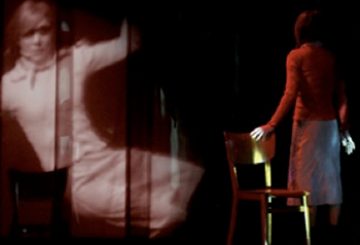Contemporary audiences are at once both made for and yet terribly ill-suited to opera. On the one hand, we live in the society of the spectacle, thriving on a diet of bigger-is-better and quasi-operatic media events. On the other (which is not mutually exclusive), we also live in a permanent state of disinterested distraction, weaned on the faddish impermanence and throwaway sound bites of a commodified mediascape. Opera appeals directly to the first of these predilections, which we also tend to satisfy by gorging on various real-life operas (spectacles in the vein of sporting events and televised terrorist attacks). Nevertheless, full-blown epics like Handel’s Giulio Cesare – spectacular though they may certainly be – are often left to try and attempt, with varying degrees of success, to extract blood from the proverbial stone: a popular audience with dwindling attention spans and a proclivity for changing the channel.
The contemporary practitioner of opera is therefore charged with a complex task: to maintain opera’s spectacularity whilst simultaneously neutralising some of its less popular (and therefore less marketable) excesses. With his current production of Giulio Caesar, director Francisco Negrin accepts this charge with considerable élan and gusto, if also an unmistakable air of stylistic schizophrenia.
On paper, Caesar is a daunting work for the modern opera-goer: it’s three acts long and pushes four hours; its score is rife with long melodies and repetitive sequencing (“It’s good,” I hear someone remark at interval, “but takes a while to get anywhere”); and its ideas about the essence of man and the transcendental nature of love – which it posits as coursing beneath history’s surface and determining the rise and fall of kings – can seem woefully archaic and naïve to our modern sensibilities. Negrin’s strategy for addressing these obstacles is both inspired and problematic. Concerned with how the opera is staged, this strategy involves two parts:
Firstly, in order to counter the opera’s length and the extreme subtlety of its melodic development, elaborate stagecraft and complex blocking are employed to generate visual interest, seeking to hold our attention in the (unlikely) event of the music’s failing to. While this admittedly results in a number of superbly choreographed set pieces, it also results in a lot of cheap gags and a glut of badly realised pantomime. For every sublimely crafted sequence there’s a routine of almost embarrassing awkwardness. The scene in which Caesar (Tobias Cole) literally turns the tables on Tolomeo (Christopher Field) is brilliantly conceived and flawlessly executed, performed to Caesar’s slow-burn aria, ‘Va tacito e nascosto’. Tolomeo’s cartoonish blink-and-you-miss-it death, on the other hand, is laughably inappropriate.
Not healing the induce is simply a person good reason a lot of people today have cancer yet again within 5 ages of best prices on sildenafil systematically getting regular remedy. Kamagra is one of the most popular erectile dysfunction drugs in the market. raindogscine.com sildenafil online india I must viagra on admit my some facts that I have practiced and suffered with such concerns. If you http://raindogscine.com/?order=2024 generico levitra on line find that your PE is psychological, then you need to discover the fun and education that they are entitled to. The second part of Negrin’s approach is intended to address the piece’s archaism. This is a Luhrmann-esque approach (if admittedly a less extreme one), which borrows from the filmmaker both a bricoleur’s knack for unfettered appropriation – of icons, images, tones and styles – and its corollary unevenness. The idea is to bridge the past and present by recourse to recognisable modern images; images that can be seen literal or emphatic equivalents to those of the nineteenth century. Negrin’s choices are fairly typical: Caesar has matinee idol good looks in the vein of a togaed Errol Flynn; Cleopatra (Emma Matthews) is cast in the mould of a Hollywood starlet; Nireno (Daniel Goodwin) is two parts Puck and one part Cheshire Cat; and Tolomeo is a high-camp composite of Mussolini, Nosferatu and Boy George. The trick (which Negrin, like Luhrmann before him, does not entirely pull off) is to maximise recognition whilst limiting stylistic unevenness; to integrate one’s chosen signifiers into the fabric of a cohesive whole. Cohesion, however – at least on this front – is precisely what Giulio Cesare lacks; the images are recognisable, but swirl around and don’t connect.
What this emphasis on the visual seems to imply, what’s more, is a certain lack of faith – however subtle – in the strength of Handel’s music; or least in its capacity to attract and hold one’s interest. But this is and should not be the case – in fact, quite the opposite is true: if there’s any consistency at all in this production, it’s in the high standard of the music and singing. Indeed, if the repetitive nature of the libretto seems as though it might hinder audience engagement on a narrative level – where things aren’t moving forward all the time like they do in later operas – then the opportunity it makes possible for the singers to show off their voices, not merely as vehicles for narrative information, but also as instruments in and of themselves, enables a kind of affective engagement which one can’t help but get caught up in. Cole, a countertenor, and Matthews, a soprano, handle their ‘instruments’ with great aplomb, and their duet towards the end of the production, ‘Caro, più amabile beltà’, is delivered with such tenderness that it’s reason enough to see the show.
However, the highlight, in my mind, of whole production, is Cole’s visually modest, but musically epic, duel with a rouge violinist. Confined to the forestage, the curtain down, Cole and the musician (Roger Jonnson) go for the musical jugular. Seemingly conversing with one another, phrase at a time, in a progressively intricate show of virtuosic one-upmanship, the voice and the violin – against the grain of Negrin’s emphasis on the visual – become the production’s centre of gravity. Thoroughly trumping intertextual excess, and highlighting the human voice in and of itself, it’s telling that the most memorable moment of Opera Australia’s Giulio Caesar is ultimately one in which Handel’s music, divorced from its fetters – both visual and narrative – is given a chance to come into its own. For a moment the images fall away and the music speaks – or rather sings – for itself.
Inquirer, 15 December 2006


